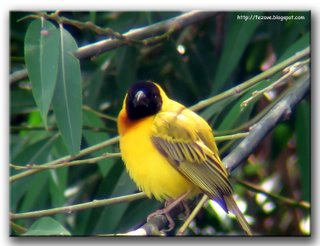BRAZO DEL ESTE (SEVILLA)

Crónica 02/07/2006
Jornada entretenida y con sorpresa final. He madrugado y he llegado al Brazo a las 06,30 h. y me he instalado debajo de un viaducto al lado de una tabla de arroz, ya que la última vez había mucho pájaro por allí. Tuve que salir a la media hora, porque ME COMIAN LOS MOSQUITOS, había nubes de ellos, me puse hasta 5 parches antimosquito de los que venden en las farmacias, y ná de ná, había mosquitos que picaban a 1 cm. del parche. Luego, me fuí siguiendo el carril principal y estando parado porque ví a 3 Chorlitejos patinegros en el mismo carril, apareció mi amigo Diego y ¡me espantó a los 3 chorlitejos!. Estuvimos pateando un rato por un camino y luego cogimos los coches y nos dirigimos por un sitio que no solemos frecuentar y ¡BINGO!, me bajé del coche porque ví Martinetes en unos árboles, cuando de repente se posó en un cañizo un TEJEDOR DE CABEZA NEGRA, me puse to nerviosito y le dije a Diego, ¡mira, mira, mira!, un Tejedor, Diego decía ¿dónde?, y yo "allí, allí", total, que el bicho salió volando y se posó en la otra orilla, e intentándo hacerle fotos, nos percatamos de que había 5 nidos y al menos dos parejas de Tejedores. Al final les hicimos algunas fotos. Estos pájaros son procedentes de escapes de particulares y almacenes importadores de aves y llevan varios años reproduciéndose en el Brazo del Este, ya que han sido anillados ejemplares por el grupo GOSUR y llevan varios años observándolos y creo que todavía la SEO no ha admitido que son nidificantes, no lo sé. Se han dejado ver las siguientes especies:
Entertaining day and with final surprise. I have got up early and come to the Brazo del Este to the 06,30 h. and have established myself under a viaduct next to a table of rice, since the last time there was very much bird there. I had to go out at the half hour, because THE MOSQUITOS WERE EATING ME, there were clouds of them, I put up to 5 patches on antimosquito of those who sell in the drugstores, and nothing of nothing, there were mosquitos that were stinging to 1 cm. of the patch. Then, I was following the principal rail and being stopped because I saw 3 Kentish plovers in the same rail, there appeared my friend Diego and he me frightened the 3 kentishes.We were walking awhile for a way and then we took the cars and went for a place that we are not in the habit of frequenting and BINGO!, I stooped the car because I saw Night Herons in a few trees, when suddenly there settled in a hurdle a BLACK HEAD WEAVER, became very nervous and said to Diego, look, look, look, a Weaver!, Diego was saying where?, and I " there, there ", then the bird went out flying and it settled in another shore, and trying to do photos to him, we observe that there were 5 nests and at least two couples of Weavers. Ultimately we did some photos to them. These birds are proceeding from leaks of importer stores of birds and go several years reproducing in the Brazo del Este, since specimens have been ringed by the group GOSUR and go several years observing them and I believe that still the SEO has not admitted that they are nidificantes, do not know it. They have been left to see the following birds:
Zampullín Común (Tachybaptus ruficollis), Avetorillo Común (Ixobrychus minutus), Martinete Común (Nycticorax nycticorax), Garcilla Bueyera (Bubulcus ibis), Garceta Común (Egretta garzetta), Garza Real (Ardea cinerea), Garza Imperial (Ardea purpurea), Cigüeña Blanca (Ciconia ciconia), Morito Común (Plegadis falcinellus), Espátula Común (Platalea leucorodia), Anade Friso (Anas strepera), Anade Azulón (Anas platyrhynchos), Cerceta Pardilla (Marmaronetta angustirostris), Milano Negro (Milvus migrans), Aguilucho Lagunero Occidental ( Circus aeruginosus), Gallineta Común (Gallinula chloropus), Calamón Común (Porphyrio porphyrio), Focha Común (Fulica atra), Cigüeñuela Común (Himantopus himantopus), Avoceta Común (Recurvirostra avosetta), Canastera Común (Glareola pratincola), Chorlitejo Patinegro (Charadrius alexandrinus), Archibebe Común (Tringa totanus), Andarríos Grande (Tringa ochropus), Gaviota Sombría (Larus fuscus), Charrán Común (Sterna hirundo), Fumarel Cariblanco (Chlidonias hybridus), Abejaruco Común (Merops apiaster), Cogujada Común (Galerida cristata), Golondrina común (Hirundo rustica),Avión común (Delichon urbica), Avión Zapador (Riparia riparia), Lavandera Boyera (Motacilla flava), Buitrón (Cisticola juncidis), Carricero Común (Acrocephalus scirpaceus), Carricero Tordal (Acrocephalus arundinaceus), Mosquitero Común (Phylloscopus collybita), Estornino Negro (Sturnus unicolor), Pico de Coral (Estrilda astrild), Jilguero (Carduelis carduelos), Tejedor de cabeza negra (Ploceus melanocephalus)
La nota triste la puso una decena de aviones zapadores atropellados en el carril principal, y es que toman baños de arena en bandos grandes y es que hay coches que circulan por el carril a 80 ó 90 km/h.
The sad note put a dozen of sand martins knocked down in the principal rail, and it is that they take baths of sand in big decrees and is that there are cars that circulate along the rail to 80 ó 90 km/h.
Eso es todo.
Foto: Tejedor de cabeza negra (Ploceus melanocephalus)
Más fotos en: http://www.galeriade.com/fezave
It is quite.
Photo: Black Headed Weaver (Ploceus melanocephalus)
More photos in: http: // www.galeriade.com/fezave







0 Comments:
Publicar un comentario
<< Home